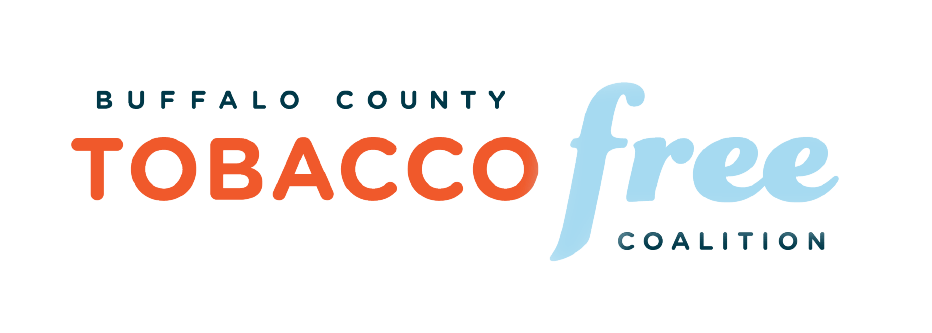Luxury Smoking Environments Created
The American Nonsmokers’ Rights Foundation reports that over 80% of the U.S. population lives in a locale covered by smokefree provisions in workplaces, restaurants and bars, some 22,601 municipalities in total. The industry lost that battle, but because of it, a brand new business opportunity presents itself: Creating environments for smoking experiences, a true luxury now that smokers have been literally kicked to the curb. Read more here.
Marijuana Smoke and Its Effects
With the expansion of legalized marijuana laws, there are a lot of questions about secondhand marijuana smoke and its effects on the non-smoker. Though the newly legal marijuana industry may say “don’t panic,” smoke is still smoke. Marijuana smoke is not “cleaner” because it’s less processed than tobacco. ANR’s newly published position paper, Protecting Nonsmokers from Secondhand Marijuana Smoke, is the first to start dealing with these important questions.
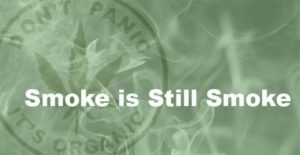
Free Nicotine Replacement Aids
NRT is available at no cost!
The Nebraska Tobacco Quitline is providing a two-week supply of over-the-counter nicotine replacement aids at no cost (one of the following: gum, patches or lozenges) while supplies last.
Please see the Quitline NRT promotional flyer or the Spanish Quitline NRT promotional flyer for more detailed information.
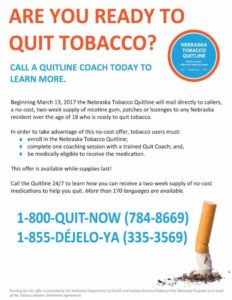
Smokers Regret Starting to Smoke
The majority of smokers (71.5%) regretted starting to smoke. Read more about the International Journal of Environ Research and Public Health report here.
Physicians Not Asking Adolescents If They Smoke
Strong evidence links tobacco counseling in the doctor’s office to tobacco prevention and cessation, but less than half of adolescents who visited a doctor in the last year were asked if they use tobacco.
Tobacco use is the leading cause of preventable death, but physicians aren’t always asking adolescents if they smoke, according to a new Truth Initiative® study.
Toolkit Helps Improve Employee Wellness
The average American working full-time spends more than one-third of their day, five days per week at work; therefore, businesses can provide substantial opportunities for health protection, health promotion and disease prevention programs.
The Nebraska Worksite Wellness Survey was conducted in 2010 to guide the development of the Nebraska Worksite Wellness Toolkit. The purpose of the Toolkit is to help businesses improve employee wellness by providing training and resources for implementing health-enhancing policies and environmental changes at worksite.
Death Rate Declines for African Americans
The death rate for African Americans has declined by 25% from 1999 to 2015. While they are living longer, they are living with or dying in their 20s, 30s, and 40s from conditions typically found in older people including: heart disease, stroke, and diabetes. Risk factors for these diseases often go unnoticed or undiagnosed during these early years. The Vital Signs report has a variety of infographics and other materials.
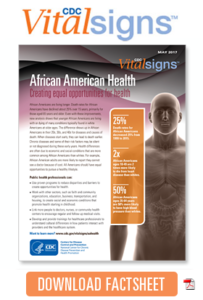
Flavored Cigarette Ban Effects Diminished by Availability of Menthol Cigarettes
The American Journal of Preventive Medicine suggest the 2009 flavored cigarette ban did achieve its objective of reducing adolescent tobacco use, but effects were likely diminished by the continued availability of menthol cigarettes and other flavored tobacco products. Read more here.

Banning Retail Sales to Minors Effective in Reducing Tobacco Use
The Journal of Health Economics found that evidence suggests that not only are e-cigarettes and smoking regular cigarettes positively related and not substitutes for young people, banning retail sales to minors is an effective policy tool in reducing tobacco use. Read more here.
5 Ways Communities Can Reduce the Number and Density of Local Tobacco Stores
ChangeLab Solutions and CounterTobacco.org illustrates five ways communities can reduce the number and density of local tobacco stores. Reducing the density and number of tobacco retailers is a promising strategy for decreasing tobacco use, curbing exposure to tobacco marketing, and promoting health equity. Read more here.

No Menthol Sunday
The National African American Tobacco Prevention Network (NAATPN) has created a toolkit for “No Menthol Sunday” which will be celebrated on May 28th.
For those of you with outreach activities and partnerships in the African American community and faith communities, this may be an opportunity to expand their knowledge on menthol and encourage their active participation in cessation.

NAATPN communication
NAATPN toolkit
Thirdhand Smoke
A fairly new term, thirdhand smoke, is getting a lot of recent attention as research is beginning to emerge about the potential dangers, and the links between exposure and disease. Read more here.
Smoke-Free Public Housing Policy Resources
Centers for Disease Control and Prevention has a new webpage that lists resources and information aimed at organizations involved in public housing in conjunction with the HUD smoke-free rule. See resources to help encourage the adoption of smoke-free policies in multi-unit public housing here.
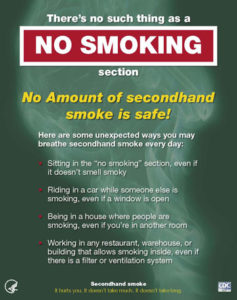
June is National Healthy Homes Month
More than one in three nonsmokers who live in rental housing are exposed to secondhand smoke, and many who live in public housing are particularly vulnerable to the effects of secondhand smoke, including children, the elderly, and people with disabilities.
The U.S. Department of Housing and Urban Development (HUD) Office of Lead Hazard Control and Healthy Home (OLHCHH) and its partners are promoting National Healthy Homes Month this June. The theme this year is “Just What the Doctor Ordered”.
Download the National Healthy Homes Planning Guide.
Answers About Smoke-Free Policies and More
In this handout,Tobacco Control Legal Consortium clarifies the complicated area where smoke-free policies, fair housing and disability laws can intersect, and provides answers to common questions housing providers, tenants and other may have about the issue.
Virtual Field Trip Examines Effects Associated with E-Cigarette Use Among Young People
On April 25th, CDC’s Dr. Brian King and Discovery Education visited a high school and engaged with students about the science and health effects associated with e-cigarette use among young people in Discovery Education’s Virtual Field Trip – an educational experience streamed directly to about 650 classrooms across the country reaching nearly 27,000 students.
Why Tobacco Didn’t Fail
Despite new regulations and a decline in the number of people who smoke, Big Tobacco continues to profit with a powerful business model – addiction.
Upcoming Events
[column column=”one_third”] 2017 Nebraska Healthcare Quality Forum
May 18, 2017 | La Vista, NE
An opportunity to learn and share about improving care within our communities. Details and registration information here.
[/column][column column=”one_third”] Youth Activism Fellowship Program
12-month leadership development program
An approach to equip emerging tobacco control professionals with the knowledge, tools and resources to support tobacco prevention in communities. Applications due by:
May 31, 2017. More details here. [/column]
[column column=”one_third” last=”true”] Chronic Disease Summit
June 6-7, 2017 | La Vista, NE
The summit will feature national, state and local speakers highlighting current efforts toward preventing and controlling heart disease, diabetes and obesity. Workshops will also feature skills building opportunities to support the implementation of public health initiatives.
Details and registration information here.
[/column]
|
Quick Links |
